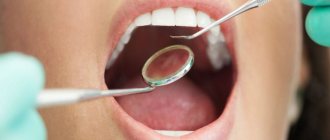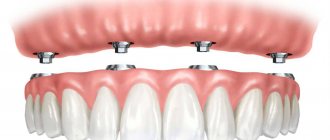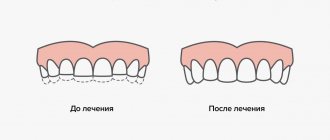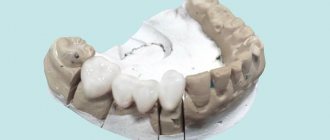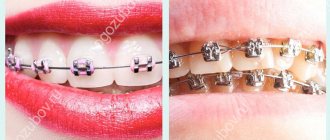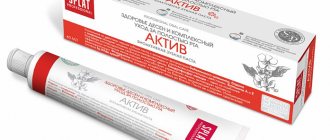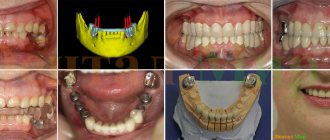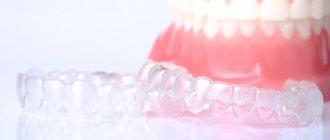When making dental prosthetics in dentistry, various materials and restoration technologies are used. One of the traditional materials, tested for decades, is gold. The qualities of elasticity, durability and strength are indicators that explain this choice.
It is this metal that can provide comfortable chewing of food for a long time and not deform. In addition, it is not an environment in which pathogenic microorganisms develop.
How to clean gold crowns from cement at home
Gold crowns are the most ancient method of dental prosthetics.
Their biggest fans are grandparents, for whom this is not only a concern for health, but also an investment in precious metals. Gold dentures easily compete in the dental services market on a par with modern analogues. What kind of doctor puts dental crowns?
Due to the softness of the metal, it is used in the form of an alloy with alloy metals - silver, platinum, copper. Depending on the percentage of components, the material for making the crown has different characteristics:
- 900 standard – characterized by softness and pliability,
- 750 sample – low level of shrinkage against the background of high elasticity,
- super-TZ is the hardest of the alloys.
The type and purpose of the required structure determines the choice of material. Wear-resistant alloys are not used in dental practice, so in any case the product will be durable and reliable.
Gold is used in the form of an alloy with silver, platinum, copper
Example subheading, maximum number of lines 2
- example of using points
- example of using points
- example of using points
- example of using points
The central topic of discussion was the basic concept of the ALL-ON-4 “all on four” technique, the essence of which is the use of four dental implants. This is a method of full denture prosthetics in the absence of all teeth. Note that the ALL-ON-4 method is an alternative to classic removable dentures. The central topic of discussion was the basic concept of the ALL-ON-4 “all on four” technique, the essence of which is the use of four dental implants. This is a method of full denture prosthetics in the absence of all teeth. Note that the ALL-ON-4 method is an alternative to classic removable dentures.
The second day was devoted to a live operation, which was jointly performed by specialists - Liliya Sterligova and Alexander Bikbaev with Spartamed doctors. This contributed to consolidating the acquired skills in practice. The patient received a prosthesis immediately after implantation.
The main objectives of the Spartamed clinic are the professional growth of doctors and the provision of highly qualified medical care to patients at all stages of treatment.
We believe that comfortable treatment is impossible without the patient's trusting attitude. The Spartamed dentist will conduct an examination, tell you in detail how the treatment will be carried out, and discuss with you the features of using various techniques and the economic component of the treatment. The doctor will separately discuss pain relief options, so even complex manipulations will take place without pain and stress. Make an appointment for effective and high-quality treatment.
Are gold crowns being installed now, and in what cases?
In the USSR, gold was widely used in prosthetics. And now, in certain situations and in certain clinics that have a special license to work with precious metals, precious teeth can be supplied. Here are the main indications:
- Allergic reactions to other dental materials;
- The need to restore chewing teeth on the upper and lower jaws.
Gold crowns are placed under certain conditions:
- Careful preparation, including turning the enamel;
- The absence of dental products made of other metals in the mouth, in order to avoid electrochemical reactions, damage to healthy tissue and poisoning.
There are still opportunities for interested patients - for example, to take advantage of gold crowns as a type of prosthetics and get rid of its disadvantages - to do ceramic coating and maintain aesthetics. Next is a more detailed comparison of various prostheses for patients who make a responsible choice.
Advantages and disadvantages of gold crowns compared to others
We have compiled a table showing the differences between microprostheses depending on the material:
| Character/species | Gold | Metal ceramics | Metal-free ceramics | Zirconium dioxide |
| Aesthetic indicators | Not used in the smile area due to its specific appearance | It is better not to use in the smile area | High aesthetic indicators, placed in the smile zone | Ideal aesthetics, suitable for any area |
| Human tissue compatibility | Complete, does not cause allergies | There may be allergic reactions | Complete, does not cause allergies | Complete, does not cause allergies |
| Chemical interaction with saliva and food components | No | May be | No | No |
| Protective effect for abutment teeth | Yes. The gold crown fits tightly, the metal has an antibacterial effect | A carious process may well develop under the structure. | A carious process may well develop under the structure. | A carious process may well develop under the structure. |
| Strength and resistance to stress | High | High | Average | The tallest |
| Risk to the enamel of the opposing tooth | No | Eat | Eat | Eat |
| Risks of chips and other damage | No | Eat | Eat | Minimal |
| Service life | Up to 20-25 years | Up to 7-10 years | Up to 10-15 years | Up to 10-15 years |
| Price | High | Depends on the underlying metal | High | The tallest |
As you can see, there is a lot to think about. In any case, the choice of whether to install gold crowns or prefer another material should be made after a thorough diagnosis, taking into account all individual characteristics.
How long can the product be used?
Gold crowns have a long service life - 15-20 years. Careful attitude and appropriate hygienic care can extend it to 25. But again, you need to look at the condition of both the supporting and opposing teeth. Nothing will happen to the crown itself during this time, but the rest, the living tissues, gradually fail. This explains the need to replace the prosthesis.
Despite the numerous advantages of using gold crowns in dental prosthetics, today dentistry still offers more advantageous options for crowns. For example, those made on the basis of zirconium dioxide or metal-ceramic on a gold basis. Such dentures will not only be strong and durable, but will also add naturalness and aesthetics to your smile.
Author: Sambuev B. S. (Thank you for your help in writing the article and the information provided)
Types of gold dental crowns
There are two types of gold crowns for teeth:
- stamped - considered an outdated method of prosthetics made from industrial blanks (sleeves) or plates. They have a lot of disadvantages: lack of aesthetics, risk of gum injury, loose fit, the need to use a large amount of cement, in which gaps form over time,
- solid cast - a more modern method, which is based on the use of special equipment. They make it possible to exactly replicate the contour of a natural tooth, do not cause harm to soft tissues, and are characterized by a long service life. Among the disadvantages is the need to grind down a large amount of the tooth before installation.
In addition, gold products can be partially or completely covered with ceramics (metal-ceramic products), but they belong to a different type of prosthetics.
Plastic structures on a metal frame are recommended for temporary wearing during the production of a permanent bridge, its repair, as well as for getting used to the structure in the mouth. They do not have sufficient aesthetics, convenience and durability. Service life - 2 - 3 years. Due to the alkaline environment in the oral cavity, plastic turns yellow, darkens and can be destroyed. They are often installed in the smile area. The price of the structures is minimal.
A restoration method with the most natural visual effect due to the transparency of the crown edge, like a real tooth. Such bridges are more durable than metal-ceramics and have a long service life of up to 20 years. Computer modeling ensures a highly accurate fit to the patient’s dental system. Errors are minimal, which is important when restoring a large number of lost elements. With this approach, the load on the maxillotemporal joint will be uniform. Installation on 3 teeth is allowed if these are chewing molars and premolars (each case requires individual consultation with a doctor).
What can they do in dentistry?
If the crown of a tooth falls off, then when you visit a specialist, the outcome may be different. First, the dentist will examine your mouth. If necessary, an x-ray examination is performed to assess the situation with the tooth root. The further outcome of events depends on the state of the artificial element and the supporting unit:
- If the condition of the prosthesis is normal, the doctor may suggest fastening the same product again. This method is the simplest and will cost much less than others. Minor scratches and chips are masked using composite compounds.
- If a fallen crown lasts longer than the specified service life, or the product is damaged, a new design will be required.
- If the reason lies in the supporting unit (for example, the root has become loose or some disease has been detected), it must be removed. After the mucous membrane has healed, the doctor will suggest the best options for prosthetics: a bridge or installation of an implant.
If problem teeth are detected, for example, in the presence of caries, full treatment is first carried out, and only then prosthetics are repeated.
How to install
After making the gold crown, the specialist begins installation. You can insert gold teeth in just a few steps. The approximate procedure is as follows:
- after grinding the tooth, a temporary structure is placed to protect it from destruction and discomfort;
- fitting and correction of the finished crown in the oral cavity is performed;
- the structure is installed and fixed with special cement.
Immediately after installation, you can return to your normal rhythm of life. But to be on the safe side, it is not recommended to eat hot, cold or too hard food for the first few days.
Adjustment period: main problems
Immediately after installation, you should not drink or eat for about 2 hours (the dentist will indicate a more precise time, since the duration of the period of abstinence depends on what type of cement was used for fixation). There are no special requirements regarding lifestyle changes.
In some cases, while getting used to the structure, the patient may encounter problems such as pain and discomfort, and increased tooth sensitivity. You must inform your dentist who performed the installation about any unusual or unpleasant sensations. It may be necessary to correct the position of the crown, or the situation is temporary, and the use of special products (rinse aid, paste) will be sufficient.
It will take some time to get used to, during which it is advisable to avoid eating solid foods so as not to accidentally damage your cheek or tongue.
What type of denture can be used for the upper jaw?
Crowns
This non-removable type is used when the tooth is destroyed, but the root part is healthy (otherwise it is installed on an implant). The main tasks of the crown are to protect against further destruction and restore function. In modern dentistry, the following options are most often used:
- the most popular are metal-ceramic (metal frame with ceramic lining), metal-free or zirconium dioxide
. They have high strength and excellent aesthetics - indistinguishable from your own tooth; - cast metal crowns
are also sometimes used . They are quite durable, but visible in a smile and conversation; - stamped metal ones
are the cheapest, but short-lived and noticeable, and therefore are not used so often.
Life time
– from 3 years for stamped ones, up to 10-25 years or more for zirconium dioxide and metal-ceramic. Among the latter, frames made of titanium and an alloy of palladium and gold are particularly durable.
Dental bridge
Fixed technology to compensate for several adjacent lost teeth - from 1 to 4. Consists of two crowns, between which artificial units are located. The structure is installed on your own (supporting) teeth, and if they are missing or in poor condition, on implants. The most popular types of dental bridges are metal-ceramic, metal-free, and zirconium dioxide. They are strong enough to be used on painters and provide optimal pressure on the gums. Service life is from 10-15 years. Among the advantages of this technology:
- invisibility
– can be used even on the most visible areas of the upper jaw; - high level of restoration
of chewing functions; - comfort
for the patient - a minimum of contraindications, a short period of adaptation (from several hours to several days), after which the bridge completely ceases to be felt.
Indications and contraindications
When is it indicated to insert gold artificial teeth:
- if necessary, restore the anatomical shape of the tooth;
- if necessary, restore full chewing function;
- for strengthening;
- to improve aesthetic performance;
- if there is a strong bite;
- with bruxism.
Contraindications include:
- patient age under 16 years;
- chronic periodontitis;
- mental illness;
- period of bearing a child.
What alloys are they made of?
The list of materials that are suitable for the manufacture of such structures includes:
- alloy of chromium and cobalt
- chromium-nickel alloy
- high titanium alloys
- alloys containing precious metals (precious alloys)
Interesting fact! Titanium is resistant to aggressive factors, does not darken and does not provoke the development of allergic reactions, therefore it is often included in alloys for the manufacture of cast dentures. And alloys containing gold in their composition are characterized by ductility, which ensures an accurate fit to the gum.
Solid crowns are also divided into the following types:
- metal coated
- metal without coating
- metal with ceramic lining
- combined bridges
Designs without coating are usually made of polished metal, are low in cost, but are often not suitable for patients due to their unaesthetic appearance. Metal structures coated with gold look more attractive. However, spraying can negatively affect the mucous lining of the oral cavity.
Solid crowns with veneer are covered with ceramic material and look the most aesthetically pleasing. For longevity, recommended care instructions must be followed. A combined prosthesis is made from several metal-ceramic prostheses (which cover the smile area) and from solid crowns.
Dishwashing liquid
Dish cleaning products contain active substances that remove even the most stubborn stains. They can be used to wash not only plates and pots, but also jewelry. Pour warm water about 38-40 °C into a container, add a few drops of liquid dishwashing detergent and stir. Do not use hot or boiling water, especially if your jewelry contains fragile gemstones: they may crack or change color when exposed to high temperatures. Soak gold items in the solution for about 20-30 minutes. Take them out and scrub them with a toothbrush with the softest bristles to remove dirt in hard-to-reach places. Rinse the gold with tap water and blot dry with a soft cloth.
Lemon
Lemon is famous for its cleansing properties. The citric acid contained in this citrus perfectly removes dirt from jewelry without damaging it. To restore its original appearance and characteristic shine, thoroughly rub the gold with a slice of lemon and then rinse with water. Wipe them with a paper towel and leave to dry. Finish by polishing with a soft cloth.
